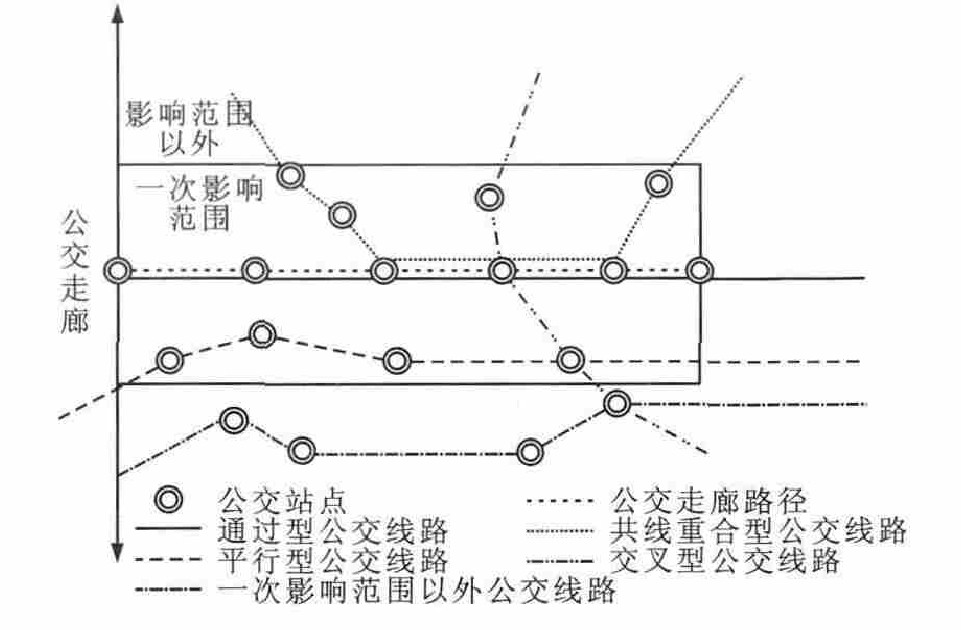Combined optimization model of bus-only lane location and transit route network
-
摘要: 提出了基于公交走廊的专用道选址和公交线网同步调整的组合优化设计思路, 并构建了双层优化模型, 上层模型以最小化用户出行成本、公交运营成本和最大化线路运营效率为目标, 寻找最优的专用道选址与公交线网优化组合优化方案, 下层模型以最小广义出行成本为目标, 进行小汽车和公交车的客流分配。利用遗传算法对模型进行求解, 通过算例对模型的有效性和实用性进行验证, 并对模型的关键参数进行灵敏性分析。分析结果表明: 优化后线路覆盖站点率为100%, 覆盖63个路段, 路段覆盖率为76%;路网总出行成本为525 147元, 比现有总出行成本655 282元降低了20%;公交线网效率目标值为234人次·h-1, 比现有公交线网效率179人次·h-1提高了31%。可见, 基于公交走廊的专用道选址与公交线网组合优化方案明显优于单一优化公交专用道选址与单一调整公交线网方案, 能够更好发挥公交走廊的网络效益。Abstract: The combined optimization design idea of simultaneously adjusting bus-only lane location and transit route network based on transit corridor was proposed, and two-level optimization model was designed to find the optimal combined design approach of bus-only lane location and transit route network.The combined optimization approach of bus-only lane and transit route network was solves by using the upper-level model with the minimum travel cost, operating cost of bus and maximum operating efficiency of road network, and the passenger flows of car and bus were distributed by using the lower-level model with the minimum generalized travel cost. The genetic algorithm was used to solve the model, the effectiveness and practicability of the model were verified through a case, and the sensitivities of key parameters of the model were analyzed.Analysis result shows that after optimization the routes cover 100% of bus sites and 63 road sections, the coverage proportion of road sections is 76%.The totaltravelling cost in route network is 525 147 yuan, and decreases by 20% compared with present cost 655 282 yuan.The efficiency target value of transit route network is 234 person-times per hour, and increases by 31% from 179 person-times per hour available now.Obviously, the combined optimization approach of bus-only lane location and transit route network based on transit corridor is obviously preferable to the approaches of simply optimizing bus-only lane location and simply adjusting transit route network, and gives play to the network benefits of transit corridor better.
-
Key words:
- public transit /
- transit corridor /
- bus-only lane /
- transit route network /
- genetic algorithm
-
表 1 各集合及其含义
Table 1. Sets and their meanings

表 2 0-1变量及其含义
Table 2. 0-1 variables and their meanings

表 3 参数及其含义
Table 3. Parameters and their meanings

表 4 公交线路及发车频率
Table 4. Transit routes and departure frequencies

表 5 最优公交线路及发车频率
Table 5. Optimal transit routes and departure frequencies

表 6 不同场景的对比结果
Table 6. Comparison results of different scenarios

-
[1] 狄迪, 杨东援. 城市公共交通走廊动态客流分析模型[J]. 同济大学学报: 自然科学版, 2014, 42(10): 1523-1529. doi: 10.11908/j.issn.0253-374x.2014.10.010DI Di, YANG Dong-yuan. Dynamic passenger flow analysis model in urban public transportation corridor[J]. Journal of Tongji University: Natural Science, 2014, 42(10): 1523-1529. (in Chinese). doi: 10.11908/j.issn.0253-374x.2014.10.010 [2] WIRASINGHE S C, SENEVIRATNE P N. Rail line length in an urban transportation corridor[J]. Transportation Science, 1986, 20(4): 237-245. doi: 10.1287/trsc.20.4.237 [3] SITE P D, FILIPPI F. Service optimization for bus corridors with short-turn strategies and variable vehicle size[J]. Transportation Research Part A: Policy and Practice, 1998, 32(1): 19-38. doi: 10.1016/S0965-8564(97)00016-5 [4] LEIVA C, MUÑOZ J C, GIESEN R, et al. Design of limitedstop services for an urban bus corridor with capacity constraints[J]. Transportation Research Part B: Methodological, 2010, 44(10): 1186-1201. doi: 10.1016/j.trb.2010.01.003 [5] 滕靖. 城市客运走廊公交行车间隔协调优化方法[J]. 同济大学学报: 自然科学版. 2009, 37(4): 490-494.TENG Jing. Coordinated optimization of bus headway for passenger corridor[J]. Journal of Tongji University: Natural Science, 2009, 37(4): 490-494. (in Chinese). [6] MESBAH M, SARVI M, CURRIE G. Optimization of transit priority in the transportation network using agenetic algorithm[J]. IEEE Transactions on Intelligent Transportation Systems, 2011, 12(3): 908-919. doi: 10.1109/TITS.2011.2144974 [7] YAO Jia, SHI Feng, ZHOU Zhao, et al. Combinatorial optimization of exclusive bus lanes and bus frequencies in multimodal transportation network[J]. Journal of Transportation Engineering, 2012, 138(12): 1422-1429. doi: 10.1061/(ASCE)TE.1943-5436.0000475 [8] SUN Xu, LU Hua-pu, FAN Yue-yue. Optimal bus lane infrastructure design[J]. Transportation Research Record, 2014(2467): 1-11. [9] DUFF-RIDDELL W R, BESTER C J. Network modeling approach to transit network design[J]. Journal of Urban Planning and Development, 2005, 131(2): 87-97. doi: 10.1061/(ASCE)0733-9488(2005)131:2(87) [10] CHEN Qun, SHI Feng, YAO Jia-lin, et al. Bi-level programming model for urban bus lanes'layout[C]//ASCE. International Conference on Transportation Engineering 2007. Reston: ASCE, 2007: 394-399. [11] ZIMMERMAN S, DAHDAH S, WANG W. Integrated corridor management for urban transport[J]. Transportation Research Record, 2012(2278): 125-133. [12] AMIRIPOUR S M M, MOHAYMANY A S, CEDER A. Optimal modification of urban bus network routes using a genetic algorithm[J]. Journal of Transportation Engineering, 2015, 141(3): 1-9. [13] CHEN Xu-mei, YU Lei, ZHU Lin, et al. Microscopic traffic simulation approach to the capacity impact analysis of weaving sections for the exclusive bus lanes on an urban expressway[J]. Journal of Transportation Engineering, 2010, 136(10): 895-902. doi: 10.1061/(ASCE)TE.1943-5436.0000155 [14] WATERSON B J, RAJBHANDARI B, HOUNSELL N B. Simulating the impacts of strong bus priority measures[J]. Journal of Transportation Engineering, 2003, 129(6): 642-647. doi: 10.1061/(ASCE)0733-947X(2003)129:6(642) [15] 雷莲桂, 孙全欣. 公交专用道路段长度与运行效果关系研究[J]. 交通运输系统工程与信息, 2009, 9(5): 160-165. doi: 10.3969/j.issn.1009-6744.2009.05.025LEI Lian-gui, SUN Quan-xin. Relationship between length of bus-only lane and operational efficiency[J]. Journal of Transportation Systems Engineering and Information Technology, 2009, 9(5): 160-165. (in Chinese). doi: 10.3969/j.issn.1009-6744.2009.05.025 [16] TRUONG L T, SARVI M, CURRIE G. Do multiple combinations of bus lane sections create a multiplier effect? a micro-simulation approach[C]//TRB. TRB 2015 Annual Meeting. Washington DC: TRB, 2015: 1-12. [17] HADAS Y, CEDER A. Optimal connected urban bus network of priority lanes[C]//TRB. TRB 2014 Annual Meeting. Washington DC: TRB, 2014: 1-17. [18] 孙杨. 城市轨道交通新线投入运营下常规公交线网优化调整方法研究[D]. 北京: 北京交通大学, 2012.SUN Yang. Methodology of bus network optimization and adjustment under the operation of urban new rail transit line[D]. Beijing: Beijing Jiaotong University, 2012. (in Chinese). [19] WARDROP J G. Some theoretical aspects of road traffic research[J]. Proceedings of the Institution of Civil Engineers, 1952, 1(3): 325-362. doi: 10.1680/ipeds.1952.11259 [20] FAN Wei, MACHEMEHL R B. Optimal transit route network design problem with variable transit demand: genetic algorithm approach[J]. Journal of Transportation Engineering, 2006, 132(1): 40-51. doi: 10.1061/(ASCE)0733-947X(2006)132:1(40) [21] 四兵锋, 孙壮志, 赵小梅. 基于随机用户平衡的混合交通网络流量分离模型[J]. 中国公路学报, 2006, 19(1): 93-98. doi: 10.3321/j.issn:1001-7372.2006.01.020SI Bing-feng, SUN Zhuang-zhi, ZHAO Xiao-mei. Mixed traffic network flow-split model based on stochastic user equilibrium[J]. China Journal of Highway and Transport, 2006, 19(1): 93-98. (in Chinese). doi: 10.3321/j.issn:1001-7372.2006.01.020 [22] YAN Ya-dan, LIU Zhi-yuan, MENG Qiang, et al. Robust optimization model of bus transit network design with stochastic travel time[J]. Journal of Transportation Engineering, 2013, 139(6): 625-634. doi: 10.1061/(ASCE)TE.1943-5436.0000536 [23] BELTRAN B, CARRESE S, CIPRIANI E, et al. Transit network design with allocation of green vehicles: agenetic algorithm approach[J]. Transportation Research Part C: Emerging Technologies, 2009, 17(5): 475-483. doi: 10.1016/j.trc.2009.04.008 [24] 李淑庆, 李哲, 朱文英. 一体化公交网络均衡配流模型[J]. 交通运输工程学报, 2013, 13(1): 62-69. doi: 10.3969/j.issn.1671-1637.2013.01.010LI Shu-qing, LI Zhe, ZHU Wen-ying. Equilibrium assignment model of integrated transit network[J]. Journal of Traffic and Transportation Engineering, 2013, 13(1): 62-69. (in Chinese). doi: 10.3969/j.issn.1671-1637.2013.01.010 [25] CIPRIANI E, GORI S, PETRELLI M. Transit network design: aprocedure and an application to a large urban area[J]. Transportation Research Part C: Emerging Technologies, 2012, 20(1): 3-14. doi: 10.1016/j.trc.2010.09.003 [26] 郭孜政, 姜梅, 张殿业, 等. 点-域匹配的公交主干线网规划方法[J]. 交通运输工程学报, 2008, 8(6): 77-81, 98. https://www.cnki.com.cn/Article/CJFDTOTAL-JYGC200806017.htmGUO Zi-zheng, JIANG Mei, ZHANG Dian-ye, et al. Planning method of bus main artery network based on pointarea match[J]. Journal of Traffic and Transportation Engineering, 2008, 8(6): 77-81, 98. (in Chinese). https://www.cnki.com.cn/Article/CJFDTOTAL-JYGC200806017.htm -





 下载:
下载:







